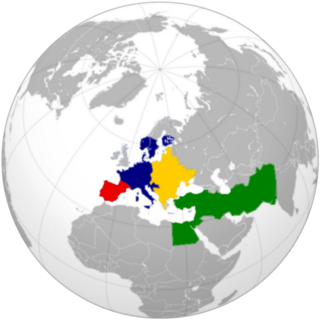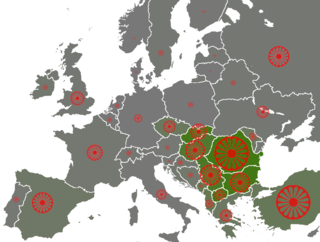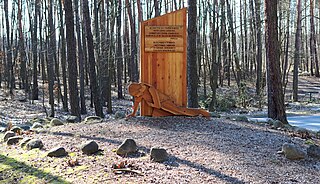
The Romani, also spelled Romany or Rromani, colloquially known as the Roma, are an Indo-Aryan ethnic group who traditionally lived a nomadic, itinerant lifestyle. Linguistic and genetic evidence suggests that the Romani originated in the Indian subcontinent; in particular, the region of present-day Rajasthan. Their subsequent westward migration, possibly in waves, is now believed by historians to have occurred around 1000 CE. Their original name is from the Sanskrit word डोम (doma) and means a member of a Dalit caste of travelling musicians and dancers. The Roma population moved west into the Persian Ghaznavid Empire and later into the Byzantine Empire. The Roma arrived in Europe around the 13th to 14th century. Although they are dispersed, their most concentrated populations are located in Europe, especially central, eastern, and southern Europe, as well as western Asia.

The Romani Holocaust or the Romani genocide was the planned effort by Nazi Germany and its World War II allies and collaborators to commit ethnic cleansing and eventually genocide against European Roma and Sinti peoples during the Holocaust era.

The Sinti are a subgroup of Romani people. They are found mostly in Germany, France and Italy and Central Europe, numbering some 200,000 people. They were traditionally itinerant, but today only a small percentage of Sinti remain unsettled. In earlier times, they frequently lived on the outskirts of communities.

The Yenish are an itinerant group in Western Europe who live mostly in Germany, Austria, Switzerland, Luxembourg, Belgium, and parts of France, roughly centred on the Rhineland. A number of theories for the group's origins have been proposed, including that the Yenish descended from members of the marginalized and vagrant poor classes of society of the early modern period, before emerging as a distinct group by the early 19th century. Most of the Yenish became sedentary in the course of the mid-19th to 20th centuries.
Bohemian Romani or Bohemian Romany was a dialect of Romani formerly spoken by the Romani people of Bohemia, the western part of today's Czech Republic. It became extinct after World War II, due to the genocide of most of its speakers in extermination camps by Nazi Germany.

The Kalderash are a subgroup of the Romani people. They were traditionally coppersmiths and metal workers and speak a number of Romani dialects grouped together under the term Kalderash Romani, a sub-group of Vlax Romani.

The Romani people are a distinct ethnic and cultural group of peoples living all across the globe, who share a family of languages and sometimes a traditional nomadic mode of life. Though their exact origins are unclear, central India is a notable point of origin. Their language shares a common origin with, and is similar to, modern-day Gujarati and Rajasthani, borrowing loan words from other languages as they migrated from India. In Europe, even though their culture has been victimized by other cultures, they have still found a way to maintain their heritage and society. Indian elements in Romani culture are almost non-existent, with the exception of their language. Romani culture focuses heavily on family. The Roma traditionally live according to relatively strict moral codes.

Anti-Romani sentiment is a form of bigotry which consists of hostility, prejudice, discrimination, racism and xenophobia which is specifically directed at Romani people. Non-Romani itinerant groups in Europe such as the Yenish, Irish and Highland Travellers are frequently given the name "gypsy" and as a result, they are frequently confused with the Romani people. As a result, sentiments which were originally directed at the Romani people are also directed at other traveler groups and they are frequently referred to as "antigypsy" sentiments.

The Romani people have several distinct populations, the largest being the Roma and the Calé, who reached Anatolia and the Balkans in the early 12th century, from a migration out of the Indian subcontinent beginning about 1st century – 2nd century AD. They settled in the areas of present-day Turkey, Greece, Serbia, Romania, Croatia, Moldova, Bulgaria, North Macedonia, Hungary, Albania, Kosovo, Bosnia and Herzegovina, Czech Republic, Slovenia and Slovakia, by order of volume, and Spain. From the Balkans, they migrated throughout Europe and, in the nineteenth and later centuries, to the Americas. The Roma population in the United States is estimated at more than one million.
The Manouches are a subgroup of Roma who have lived in France since the eighteenth century. The term Manouche is the self-ascribed name of the French Sinti. Manouche means man or human being in the Romani language. They speak the same variety of language as the Sinti which exhibits strong German influence.
Romani people in France, generally known in spoken French as gitans, tsiganes or manouches, are an ethnic group that originated in Northern India. The exact number of Romani people in France is unknown; estimates vary from 500,000 to 1,200,000.

The Romani people are also known by a variety of other names; in English as gypsies or gipsies, and Roma; in Greek as γύφτοι (gíftoi) or τσιγγάνοι (tsiggánoi), in Central and Eastern Europe as Tsingani ; in France as gitans besides the dated terms bohémiens and manouches; in Italy as rom and sinti besides the dated terms zingari, sigani, and gitani; in Spain as gitanos; and in Portugal as ciganos.
Sinte Romani is the variety of Romani spoken by the Sinti people in Germany, France, Austria, Belgium, the Netherlands, some parts of Northern Italy and other adjacent regions. Sinte Romani is characterized by significant German influence and is not mutually intelligible with other forms of Romani. The language is written in the Latin script.

The Romani are an ethnic group that has lived in Austria since the Middle Ages. According to the 2001 census, there were 6,273 Romani speakers in Austria, or less than 0.1% of the population. Estimations count between 10,000 and 25,000. A more recent estimation count between 40,000 and 50,000 Romani people or about 0.5%. Most indigenous Romani people in Austria belong to the Burgenland-Roma group in East-Austria. The majority live in the state of Burgenland, in the city of Oberwart and in villages next to the District of Oberwart. The Burgenland-Roma speak the Vlax Romani language.

Romani people in Germany are estimated to around 170,000-300,000, constituting around 0.2-0.4% of the population. One-third of Germany Romani belong to the Sinti group. Most speak German or Sinte Romani.
Roma have been living in Italy since the 15th century. The Sinti, who regard themselves as a subgroup distinct from the Roma, arrived from the north. Other Romani groups migrated from the Balkans and settled in Southern Italy and Central Italy. From Bosnia and Kosovo, Muslim Roma the so called Xoraxane came to Italy at the time of the Balkan wars

The Roma Holocaust Memorial Day is a memorial day that commemorates the victims of the Romani genocide (Porajmos), which resulted in the murder of an estimated 220,000–500,000 Romani people by Nazi Germany and its collaborators during World War II. The date of 2 August was chosen for the memorial because on the night of 2–3 August 1944, 2,897 Roma, mostly women, children and elderly people, were killed in the Gypsy family camp (Zigeunerfamilienlager) at Auschwitz concentration camp. Some countries have chosen to commemorate the genocide on different dates.

Santino Spinelli is an Italian Romani musician, composer and teacher.
Sandra Jayat is a French writer and artist of Romani descent. She left her nomadic family at age 15. She travelled on her own to Italy and Paris. She became associated with the surviving family of Django Reinhardt. In Paris, she was encouraged by the writers Marcel Aymé and Jean Cocteau, plus as an artist by Chagall and Picasso. She published many works of literature documenting the experience of Romanies in France and has advocated on behalf of Roma and Sinti at the international level, and is a recognized artist whose work has featured in well regarded exhibitions. She currently resides in Paris.

The RomArchive is a digital repository of Romani culture, established in 2015. Fourteen curators organised 5,000 objects, available in English, German and Romani. The archive has won a European Union Prize for Cultural Heritage and a Grimme-Preis.













